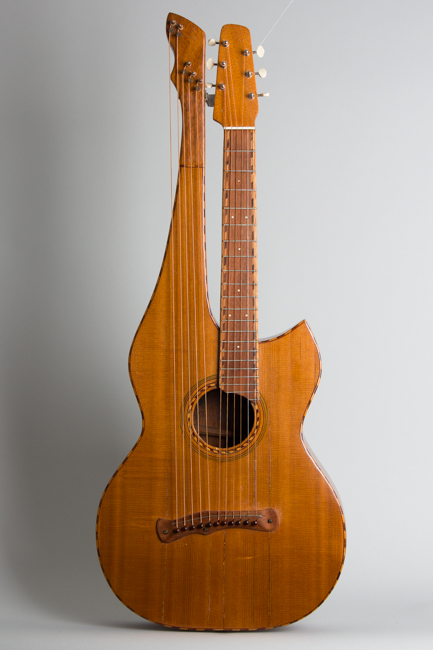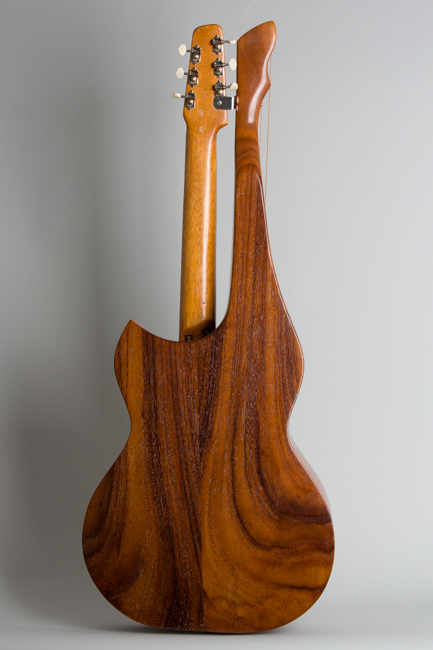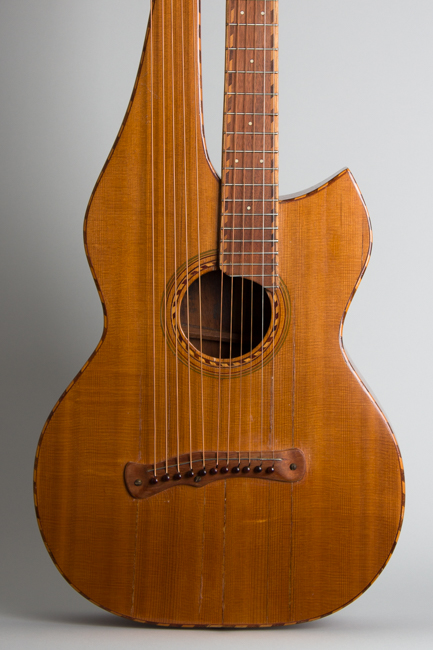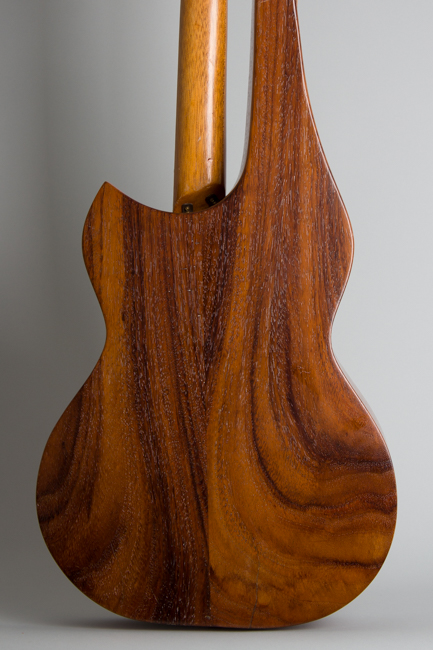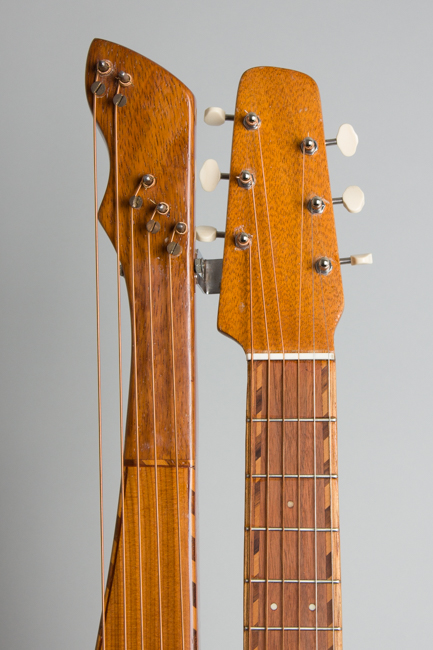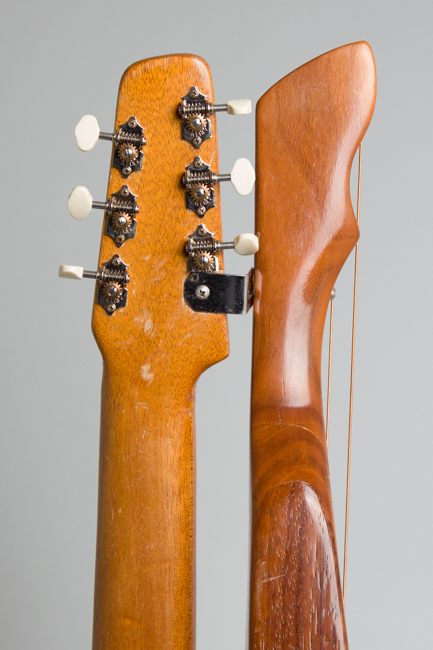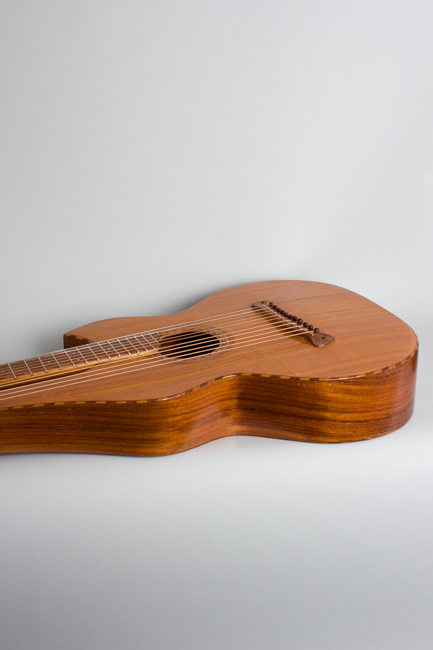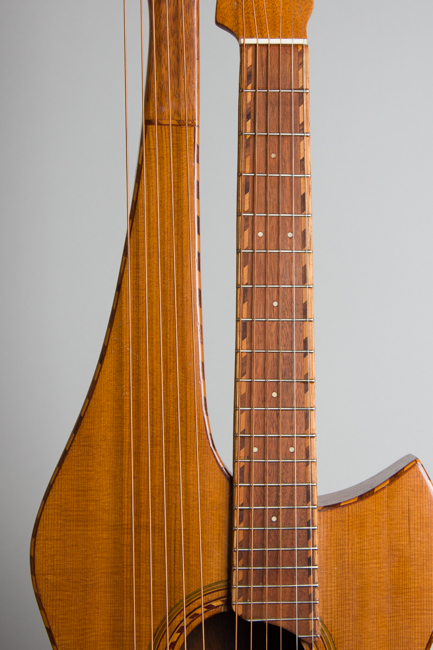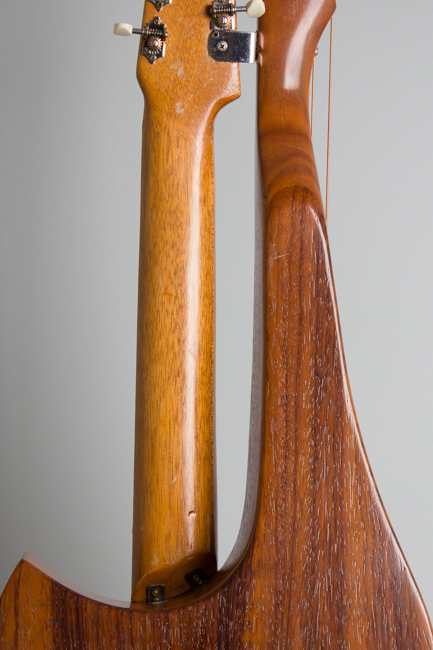Knutsen 11 String Harp Guitar , c. 1915
This item has been sold.
Item # 9937
Prices subject to change without notice.
Knutsen 11 String Model Harp Guitar, c. 1915, made in Seattle, WA, natural re- finish, Spruce top, koa back, sides and neck.
One of America's most creative (if least celebrated) 20th century luthiers was Chris Knutsen, who hand-built his always amazingly eccentric instruments on the West Coast from the 1890s up into the 1920s. His original design for a hollow-neck Hawaiian guitar was popularized by Hermann Weissenborn and his Symphony harp guitars by the Larson Brothers (under the Dyer label), but Knutsen himself never made the leap from craftsman to manufacturer. He tinkered endlessly with his unique and highly original stringed instrument concepts, coming up with one highly eccentric instrument design after another. Each completely handmade instrument is distinctive, often appearing to be built from found woods and whatever hardware was available.
This large-bodied Harp guitar dates to around 1915, towards the end of his fascination with these multi-sub-bass-string creations. It carries no label, date or other markings but the shape and Hawaiian style wood trim mark it as a late example, built in the mid-teens when Knutsen's attentions had mostly shifted to lap-style instruments. Despite 100+ years of sometimes less-than-perfect repairs it remains an amazingly good sounding and quite playable example of Knutsen's work.
Practically everything about this guitar is unconventional. Except for a standard lower bout the lines are fluid to the point of abstract shape; even the headstocks have a liquid sculpture look. The large 16 1/4' wide body has typical signature Knutsen features, including a sharp lower cutaway and the bank of 5 sub-bass strings mounted on a sweeping hollow upper-body extension. The neck is secured to the body with screw brackets, and is (to a limited degree) adjustable for angle.
The bridge is a massive carved affair, with the play and adjacent harp strings sharing a long fretwire saddle. The top is bordered in wood marquetry similar to the early Hawaiian ukes and guitars of the period and the dot-inlaid fingerboard is elaborately trimmed the same way. The sound hole has multiple wooden rings and a similar "zipper' pattern rosette. The neck is very wide with a shallow "C" profile, not unlike an exaggerated version of the famously flat-feeling 1960 Gibson neck. This is not a guitar for the conservative or faint-hearted player, but rewards the adventurous picker with a huge and surprisingly sweet and versatile sound, even if the sub-bass strings are ignored.
Overall length is 40 in. (101.6 cm.), 16 1/4 in. (41.3 cm.) wide at lower bout, and 4 3/8 in. (11.1 cm.) in depth, measured at side of rim. Scale length is 25 in. (635 mm.). Width of nut is 2 in. (51 mm.).
Despite its eccentric design and extensive repair history this remains a very playable instrument, albeit an odd-feeling one to many pickers. It sounds really excellent with power and projection to spare and a more-useful-than-many sub-bass section. These are more conveniently arrayed for the picking hand than some and with a little practice can be used to good effect
The entire instrument was refinished long ago in a clear natural lacquer, not a thoroughly professional job but not obnoxiously heavy as some older refins can be. There is some subsequent wear to this finish mostly small dings, dents and scrapes but no wholesale loss. There are a number of very noticeable top cracks, all solidly but visibly sealed, some with splices that are also not really pro-caliber work and can be felt as well as seen. There is also a repaired crack through the upper-extension heel that continues a bit along the outer side of the harp extension. This is more neatly sealed up.
There is another small side crack above the endpin, and one rather jagged back crack by the lower rim. There are also solidly sealed.
The oddly shaped bridge is original, as are the large wood screws securing it (another Knutsen trademark) while the fretwire saddle is newer. The guitar has been very nicely refretted with a new nut, an excellent job and the neck is straight and very playable. There are modern tuners on the six play strings; the original zither peg tuning for the harp strings is intact, functional if not particularly convenient as a wrench is required to tune them. This is neither the cleanest or most original of Chris Knutsen's off-the-wall masterpieces we have had, but it is one of the best sounding and easily the finest playing. Many surviving Knutsen instruments are interesting museum pieces, this is a functional instrument well suited to actual use by an adventurous player. There is no case but we were able to find a modern gig bag that is a functional fit. Overall Very Good + Condition.
One of America's most creative (if least celebrated) 20th century luthiers was Chris Knutsen, who hand-built his always amazingly eccentric instruments on the West Coast from the 1890s up into the 1920s. His original design for a hollow-neck Hawaiian guitar was popularized by Hermann Weissenborn and his Symphony harp guitars by the Larson Brothers (under the Dyer label), but Knutsen himself never made the leap from craftsman to manufacturer. He tinkered endlessly with his unique and highly original stringed instrument concepts, coming up with one highly eccentric instrument design after another. Each completely handmade instrument is distinctive, often appearing to be built from found woods and whatever hardware was available.
This large-bodied Harp guitar dates to around 1915, towards the end of his fascination with these multi-sub-bass-string creations. It carries no label, date or other markings but the shape and Hawaiian style wood trim mark it as a late example, built in the mid-teens when Knutsen's attentions had mostly shifted to lap-style instruments. Despite 100+ years of sometimes less-than-perfect repairs it remains an amazingly good sounding and quite playable example of Knutsen's work.
Practically everything about this guitar is unconventional. Except for a standard lower bout the lines are fluid to the point of abstract shape; even the headstocks have a liquid sculpture look. The large 16 1/4' wide body has typical signature Knutsen features, including a sharp lower cutaway and the bank of 5 sub-bass strings mounted on a sweeping hollow upper-body extension. The neck is secured to the body with screw brackets, and is (to a limited degree) adjustable for angle.
The bridge is a massive carved affair, with the play and adjacent harp strings sharing a long fretwire saddle. The top is bordered in wood marquetry similar to the early Hawaiian ukes and guitars of the period and the dot-inlaid fingerboard is elaborately trimmed the same way. The sound hole has multiple wooden rings and a similar "zipper' pattern rosette. The neck is very wide with a shallow "C" profile, not unlike an exaggerated version of the famously flat-feeling 1960 Gibson neck. This is not a guitar for the conservative or faint-hearted player, but rewards the adventurous picker with a huge and surprisingly sweet and versatile sound, even if the sub-bass strings are ignored.
Overall length is 40 in. (101.6 cm.), 16 1/4 in. (41.3 cm.) wide at lower bout, and 4 3/8 in. (11.1 cm.) in depth, measured at side of rim. Scale length is 25 in. (635 mm.). Width of nut is 2 in. (51 mm.).
Despite its eccentric design and extensive repair history this remains a very playable instrument, albeit an odd-feeling one to many pickers. It sounds really excellent with power and projection to spare and a more-useful-than-many sub-bass section. These are more conveniently arrayed for the picking hand than some and with a little practice can be used to good effect
The entire instrument was refinished long ago in a clear natural lacquer, not a thoroughly professional job but not obnoxiously heavy as some older refins can be. There is some subsequent wear to this finish mostly small dings, dents and scrapes but no wholesale loss. There are a number of very noticeable top cracks, all solidly but visibly sealed, some with splices that are also not really pro-caliber work and can be felt as well as seen. There is also a repaired crack through the upper-extension heel that continues a bit along the outer side of the harp extension. This is more neatly sealed up.
There is another small side crack above the endpin, and one rather jagged back crack by the lower rim. There are also solidly sealed.
The oddly shaped bridge is original, as are the large wood screws securing it (another Knutsen trademark) while the fretwire saddle is newer. The guitar has been very nicely refretted with a new nut, an excellent job and the neck is straight and very playable. There are modern tuners on the six play strings; the original zither peg tuning for the harp strings is intact, functional if not particularly convenient as a wrench is required to tune them. This is neither the cleanest or most original of Chris Knutsen's off-the-wall masterpieces we have had, but it is one of the best sounding and easily the finest playing. Many surviving Knutsen instruments are interesting museum pieces, this is a functional instrument well suited to actual use by an adventurous player. There is no case but we were able to find a modern gig bag that is a functional fit. Overall Very Good + Condition.
